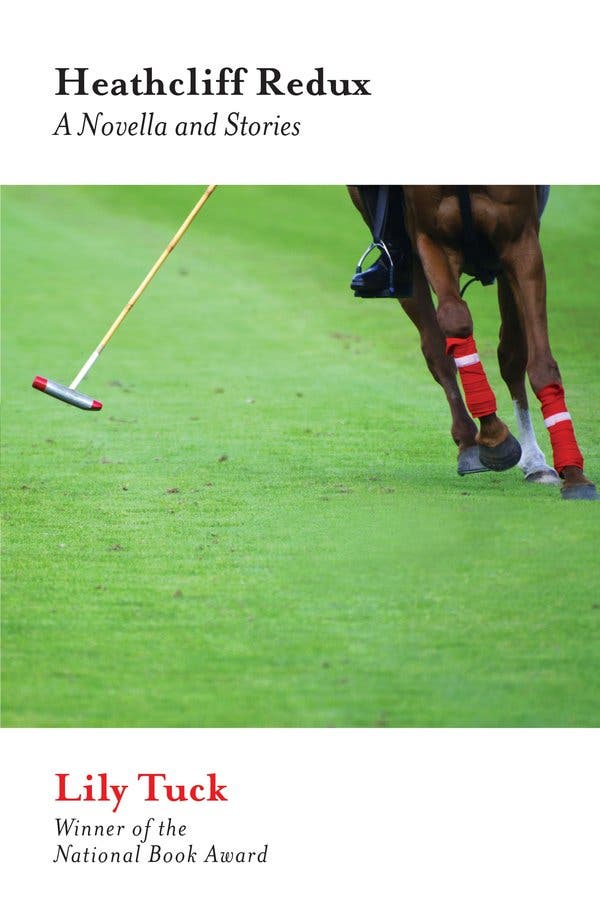HEATHCLIFF REDUX
A Novella and Stories
By Lily Tuck
“Of course I had read ‘Wuthering Heights,’” reads the opening line of “Heathcliff Redux.” “I read it years ago in high school, but, in my late 20s, I decided to read it again.” The unnamed narrator of Lily Tuck’s restrained but remarkably arresting novella is a well-to-do wife and mother in rural Virginia. Her husband, Charlie, breeds cattle on the 400-acre farm in Albemarle County where they live with their 9-year-old twin boys. It is 1963, “still a relatively innocent time — innocent, at least, for middle-class people like Charlie and me,” she reminisces. “We did not do drugs, we did not get divorced, and we did not have abortions or extramarital love affairs, or, if we did, we did not talk about them.”
Hence the relative reserve with which the narrator subsequently details her liaison with Cliff, a rakish, “reckless” horseman — he rides like a Cossack — whom she falls for with the same helpless lust with which teenage bibliophiles swoon over Emily Brontë’s brooding antihero: “It is hard to describe how handsome Cliff was, how sexy and how attracted I was.” (Readers familiar with Tuck’s earlier book “The Double Life of Liliane,” an autobiographical portrait of the author’s childhood and coming-of-age that mixed fiction, cultural commentary and personal memoir, might remember the adolescent Liliane’s attempts to write a novel about her imagined life with Heathcliff during the three years he’s away from Wuthering Heights.)

Using the same flat, fragmentary style that proved so fruitful in her most recent novel, “Sisters,” Tuck constructs her narrator’s story from a series of short, clipped sections, sometimes a couple of paragraphs, others no more than a line or two per page. It’s a master class in digression as a narrative device. A recipe for beef bourguignon, the story of a cuckoo that steals the jewels of an Italian countess, fox-hunting etiquette as detailed by the Keswick Hunt Club: Each has its role to play. Yet while “Sisters” — which was narrated by a woman obsessed with her husband’s first wife — owed an unspoken debt to Daphne du Maurier’s “Rebecca,” “Heathcliff Redux” is a much more visibly knotty intertextual exercise.
Punctuating the story of the narrator’s affair with Cliff are quotes from “Wuthering Heights,” extracts of 21st-century critical commentary on the 1847 novel and morsels from Brontë’s biography. These are the means by which Tuck enfolds various misreadings and misconceptions into the fabric of her novella — both those integral to the 1847 story and those surrounding its contemporary reception. Fittingly, Tuck’s novella eventually reveals itself to be more a tale of self-delusion and internal conflict than the grand romance we were initially led to believe.
I couldn’t help wondering, though, why four additional short stories were included alongside “Heathcliff Redux,” which could have been published as a stand-alone work like “Sisters.” It’s not that the shorter pieces are unsuccessful, far from it, but compared with the novella they feel like afterthoughts. That said, “Carl Schurz Park,” in which a young married man about to become a father remembers a horrific act of violence that he committed in his youth, is particularly evocative. While “Labyrinth Two” — a “homage of sorts” to Roberto Bolaño’s story of the same title, itself inspired by a New Yorker photograph (reproduced here) of four people sitting at a table in a cafe — intriguingly harks back to certain memorable European episodes in “The Double Life of Liliane,” a book that also incorporated Sebaldian-style images.
“Heathcliff Redux: A Novella and Stories” is a haunting if slightly unbalanced collection. There’s something endlessly fascinating in the way Tuck’s interest in literary relationships extends even to the works in her own oeuvre.
 EU News Digest Latest News & Updates
EU News Digest Latest News & Updates



